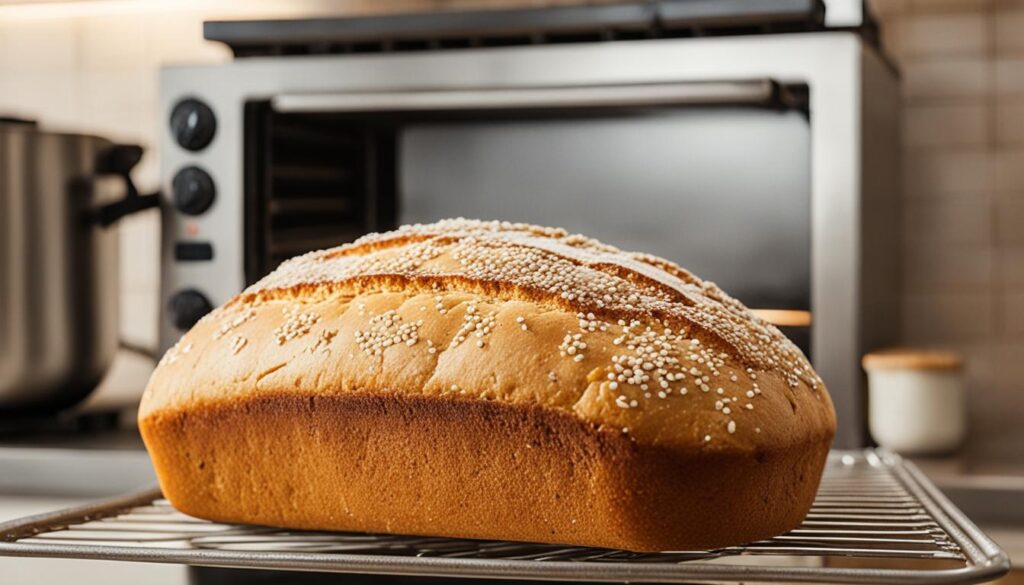Making your own sandwich bread at home is both rewarding and satisfying. This simple recipe makes a soft, fluffy, and tasty homemade bread. It’s perfect for sandwiches, toast, and more. With just a few ingredients and some time, you can enjoy freshly baked sandwich bread in your kitchen.
Sandwich Bread Recipe
Key Takeaways
- This recipe yields 32 slices of sandwich bread from 2 loaves1
- The total preparation and baking time is 1 hour1
- The recipe uses 6 cups of all-purpose flour, 2 tablespoons of yeast, and 2 cups of warm water1
- The bread can be stored frozen for up to 2 months1
- Each serving has 104 calories, 19g carbohydrates, 3g protein, and 2g fat1
Introduction to Homemade Sandwich Bread
Homemade sandwich bread is a treat that beats store-bought options in taste and texture. It has a soft inside and a chewy crust2. Plus, you can pick the ingredients yourself, avoiding preservatives found in many store loaves2. Making bread at home fills your kitchen with a lovely smell and gives you a feeling of pride.
Benefits of Homemade Bread
Homemade bread is tasty and good for you. You can choose the ingredients to fit your diet, like using whole-grain flours or cutting sugar and salt3. The fresh taste and texture of homemade bread make it a comforting treat.
Ingredients Overview
This recipe for homemade sandwich bread uses bread flour (or all-purpose flour)3, active dry yeast2, sugar2, unsalted butter2, whole milk2, and salt2. Bread flour makes the bread chewier, sugar helps the yeast and softens the dough2. Butter and milk add a soft, buttery taste and a tender crumb2. Salt boosts the bread’s flavor2.
“Homemade bread is not only delicious, but it also offers several nutritional advantages.”
Preparing the Dough
The first step in making perfect homemade sandwich bread is activating the yeast. Mix warm water, yeast, and a bit of honey or sugar in a stand mixer bowl. Let it sit for about 5 minutes4. The yeast will start to foam, showing it’s alive and ready for the dough5.
Activating the Yeast
After the yeast is activated, add butter, salt, and flour to the mixer4. Use the stand mixer’s dough hook to knead for 5-8 minutes6. Or, knead on a floured surface for the same time6. Kneading makes the dough soft and tender by developing gluten5. It should feel slightly tacky but not too sticky.
Mixing and Kneading Techniques
For a hands-on method, mix and knead the dough by hand. Use the 5:3 ratio for bread, with 5 parts flour and 3 parts water5. This means about 500 grams of flour and nearly 300 grams of water5. Knead at low speed for 2-3 minutes, then at medium speed for 8-9 minutes6. This helps develop gluten for a smooth texture.
Whether with a stand mixer or by hand, the aim is to build the dough’s gluten structure. This makes the bread soft and tender. The dough should pass the “windowpane test” when stretched thin, showing the gluten is well-developed5.
First Rise and Shaping the Loaves
After kneading the dough until it’s smooth and elastic, it’s time for the first rise. Put the dough in a bowl greased lightly, cover it, and let it rest in a warm spot for 1 to 2 hours. It should double in size7.
Then, to get rid of air bubbles, gently “punch down” the dough. Divide it into two equal parts. Roll each part into a rectangle and shape it into a loaf8.
Put the shaped loaves into greased 9×5-inch loaf pans for their second rise7.
Shaping and proofing the dough are key to making perfect homemade sandwich bread. Letting the dough rise and develop its structure gives you a soft, fluffy loaf. It’s great for sandwiches, toast, and more8.
| Step | Description |
|---|---|
| First Rise | Allow the dough to rise in a lightly greased bowl for 1-2 hours, or until it has doubled in size7. |
| Shaping | Punch down the dough to release air bubbles, then divide it into two equal portions. Roll each portion into a rectangular shape and tightly roll it up into a loaf8. |
| Panning | Place the shaped loaves into greased 9×5-inch loaf pans, ready for the second rise7. |
By following these steps, your homemade sandwich bread will rise well and have the perfect texture and shape for your recipes8.
Second Rise and Baking Process
After shaping the dough into loaves, they go into greased pans for a second rise. This step takes about 1 hour, making the dough expand and rise to 1 inch above the pan’s rim9. This second rise is key for the bread’s final shape and rise before baking10.
Proofing the Loaves
After the first rise, the dough is gently punched down to remove air pockets. Then, it’s shaped into loaves and put in baking pans. Covered, the loaves rise for about 1 hour, until they’re 1 inch above the pans9. This step is vital for the bread’s final shape and structure10.
Baking Temperature and Time
The loaves are baked in a 350°F (177°C) oven for 30-34 minutes, until golden brown on top10. Halfway through, the pans are rotated for even browning11. The bread is done when its internal temperature is between 180-190°F (82-88°C)11.
Once baked, the loaves cool on a wire rack before slicing and serving10. Cooling helps set the bread’s structure and keeps it from losing moisture.

sandwich bread recipe
The classic white sandwich bread recipe is a great start, but you can make it your own. Add dried herbs, spices, or shredded cheese to the dough for a unique taste12.
Flavored Bread Variations
For a savory flavor, mix in a tablespoon of dried rosemary, oregano, or garlic powder before the first rise13. Or, add shredded cheddar, parmesan, or mozzarella cheese for a cheesy bread13.
Want something sweet? Add raisins, dried cranberries, or chopped walnuts to the dough13. For a cinnamon-swirl loaf, spread cinnamon and brown sugar on the dough, roll it up, and slice before baking.
There are endless ways to flavor your homemade sandwich bread. Try different ingredients to make delicious and unique loaves12.
“Homemade bread is the ultimate comfort food, and the ability to customize the flavor makes it even more special.”
Whether you like savory or sweet, there’s a homemade sandwich bread for you12.
Cooling and Slicing the Bread
After baking homemade sandwich bread, let the loaves cool completely before you slice14. Most people bake at home use a loaf pan14. Remove the bread from the oven and put it on a wire rack to cool for 30 minutes11. This helps the bread cook inside and get a firm crust.
Once cooled, use a sharp serrated knife to slice the loaf into even pieces14. Many have shared tips to avoid squishing the soft bread while cutting. Slicing now makes serving easy.
Storing Homemade Bread
You can store homemade sandwich bread at room temperature in a sealed container or bag for 3 days15. Most people keep their fresh bread in plastic bags14. For longer storage, freeze it for up to 1 month15. Frozen slices thaw quickly in a toaster.
| Storage Method | Shelf Life |
|---|---|
| Room Temperature | 2-3 days15 |
| Refrigerator | Up to 1 week15 |
| Freezer | Up to 1 month15 |
Follow these steps for cooling, slicing, and storing your homemade sandwich bread. Enjoy the fresh taste of your baking for days14. Remember, how you store it affects its quality and freshness.
Tips for Perfect Sandwich Bread
Making delicious homemade sandwich bread is all about paying attention to details and following some key tips. First, use fresh, active yeast to make sure the dough rises well12. Make sure the water for activating the yeast is between 85-90°F to help the yeast grow12. Also, kneading the dough is important for building the gluten structure. This makes the bread soft and fluffy.
Troubleshooting Common Issues
If your homemade bread feels dense or dry, there are a few things to check. For breads with all-purpose flour, they need to bake until they hit an internal temperature of 190°F16. Some people like to bake them even higher, up to 194°F16. For denser, whole-grain or sweet breads, aim for temperatures between 200°F and 205°F16.
Letting the bread cool in the pan for at least 1 minute before taking it out can prevent it from falling or denting16. To get a soft, tender crust, brush the top of the bread with melted butter after baking16. Slicing the bread when it’s hot can cause it to lose moisture. So, wait until it cools down completely before cutting16.
For keeping bread fresh, slice it and freeze it. Homemade bread doesn’t have the preservatives found in store-bought types16.
By using these tips and fixing common problems, you can make perfect homemade sandwich bread that’s soft, fluffy, and tasty17. With just a few simple ingredients and some patience, you can enjoy making your own bread at home17.
Serving Suggestions and Recipes
Homemade sandwich bread is a versatile staple that can be enjoyed in many ways. Its soft, fluffy texture and buttery flavor make it perfect for classic sandwiches like grilled cheese, BLTs, or turkey and avocado18. You can also use it for toast, French toast, or as the base for breakfast or dessert recipes, such as bread pudding or cinnamon-sugar toast.
For a delightful breakfast, try making French toast with your homemade sandwich bread. Dip the slices in a mix of beaten eggs, milk, vanilla, and cinnamon. Then, cook on a hot griddle until they’re golden brown. Top with maple syrup, fresh fruit, or powdered sugar for a comforting start to the day18.
If you’re in the mood for a hearty lunch, consider making a classic grilled cheese sandwich. Layer your favorite cheese, like cheddar, Swiss, or provolone, between slices of homemade bread. Grill until the cheese melts and the bread gets crisp and golden. Serve with tomato soup for a satisfying meal18.
For a unique twist, use the homemade bread to create a breakfast casserole. Arrange cubed bread in a baking dish, then pour over a custard-like mix of eggs, milk, and seasonings. Bake until set and enjoy a hearty, make-ahead breakfast or brunch dish18.
| Recipe | Ingredients | Baking Time |
|---|---|---|
| Homemade Sandwich Bread | 2 1/2 tablespoons of active dry yeast, 3 cups of warm water, 1 tablespoon of sugar, 2/3 cup of honey, 6 cups of bread flour, 1 cup of whole wheat flour, 4 tablespoons of butter, 1 tablespoon of salt | 20 to 25 minutes at 350 degrees Fahrenheit |
Homemade sandwich bread is great for breakfast, lunch, or as a snack. Get creative with your serving suggestions and try new recipes to show off this freshly baked staple1819.
Conclusion
Making your own sandwich bread is a fun and tasty project for every home baker. You only need20 7 simple ingredients and about20 3 hours and 20 minutes to make a soft, fluffy loaf. This loaf is much better than what you can buy in stores20.
The recipe makes 1 loaf and it should bake for around20 30-34 minutes until it turns golden brown.
Baking bread at home makes your kitchen smell amazing and gives you a great feeling of achievement. This easy recipe for homemade sandwich bread will quickly become a favorite in your family20. It’s rated 5 stars by 764 people, and the guide also shows how to freeze it and prepare it overnight.
Homemade bread not only tastes amazing but also has many benefits. You can choose the ingredients, cut down on preservatives, and feel proud of making something healthy from scratch. With a focus on homemade bread benefits, easy bread recipe, and why make homemade bread, this simple yet delicious sandwich bread recipe is a must-try for any home baker. It’s a great way to improve your cooking skills and enjoy the taste of homemade bread.










